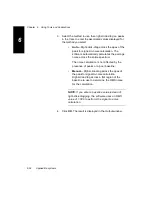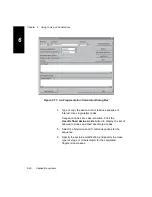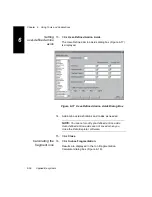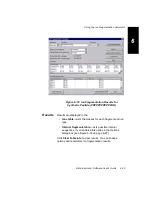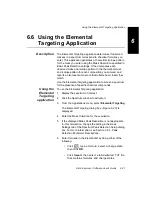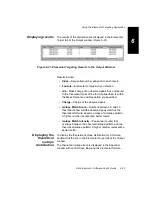
Using the Signal-to-Noise Ratio Calculator
Data Explorer
™
Software User’s Guide
6-23
6
6.4 Using the Signal-to-Noise Ratio
Calculator
Description
A signal-to-noise ratio is typically used to describe how well a
peak of interest in a spectrum or chromatogram is
distinguished from background noise.
The Data Explorer software provides two signal-to-noise ratio
methods that calculate signal-to-RMS noise (electronic and
chemical):
•
Auto—You specify the peak for calculation and the
software automatically calculates the average noise
across the spectrum.
•
Manual—You specify the peak and the baseline region
for calculation. For accurate results, this method requires
a flat (non-rising) baseline that does not include peaks.
The manual method is useful when evaluating a narrow
region around a peak to determine the relative
significance of a peak.
Calculating
signal-to-noise
ratio
To calculate a signal-to-noise ratio:
1.
Click the Spectrum window to activate it.
2.
From the Tools menu, select S/N Calculator.
The Signal-to-Noise Calculator dialog box (Figure 6-14)
is displayed.
Figure 6-14 Signal-to-Noise Dialog Box
Summary of Contents for Data Explorer 4 Series
Page 1: ...Data Explorer Software Version 4 Series Software User Guide ...
Page 10: ...Table of Contents x Applied Biosystems ...
Page 56: ...Chapter 1 Data Explorer Basics 1 42 Applied Biosystems 1 ...
Page 98: ...Chapter 2 Using Chromatogram and Spectrum Windows 2 42 Applied Biosystems 2 ...
Page 172: ...Chapter 3 Peak Detection and Labeling 3 74 Applied Biosystems 3 ...
Page 204: ...Chapter 4 Examining Chromatogram Data 4 32 Applied Biosystems 4 ...
Page 270: ...Chapter 5 Examining Spectrum Data 5 66 Applied Biosystems 5 ...
Page 316: ...Chapter 6 Using Tools and Applications 6 46 Applied Biosystems 6 ...
Page 384: ...Chapter 9 Troubleshooting 9 22 Applied Biosystems 9 ...
Page 388: ...Appendix A Warranty A 4 Applied Biosystems A ...
Page 416: ...Appendix C Data Explorer Toolbox Visual Basic Macros C 20 Applied Biosystems C ...
















